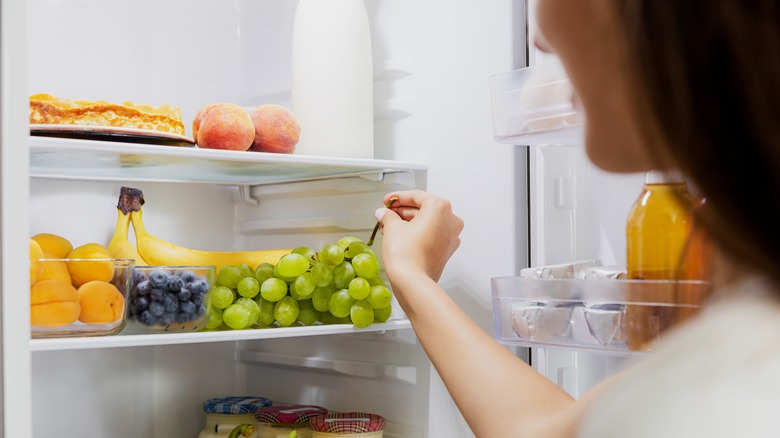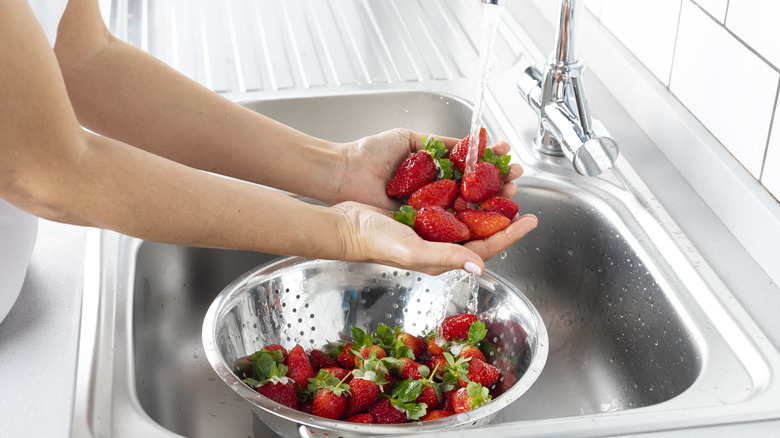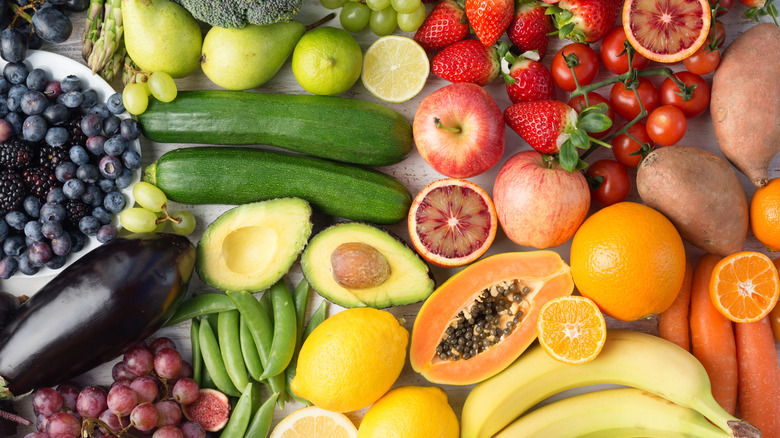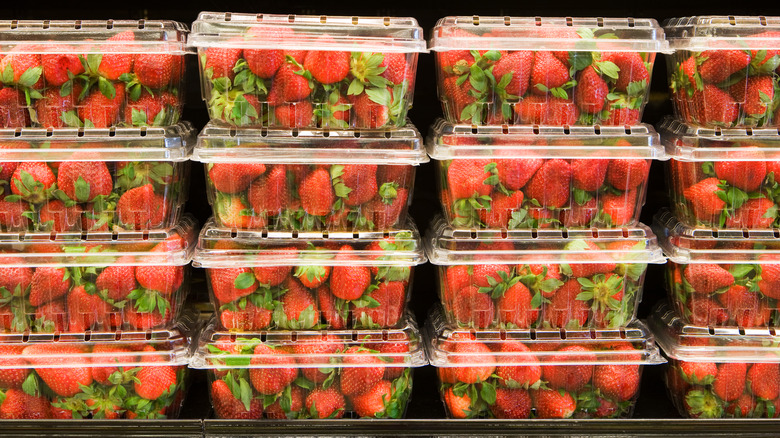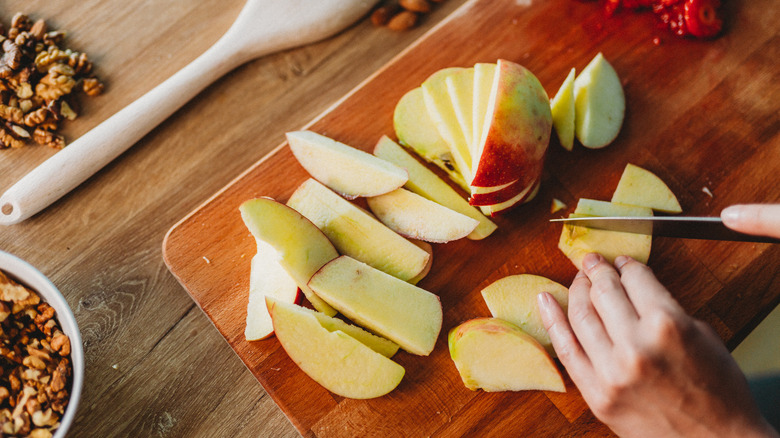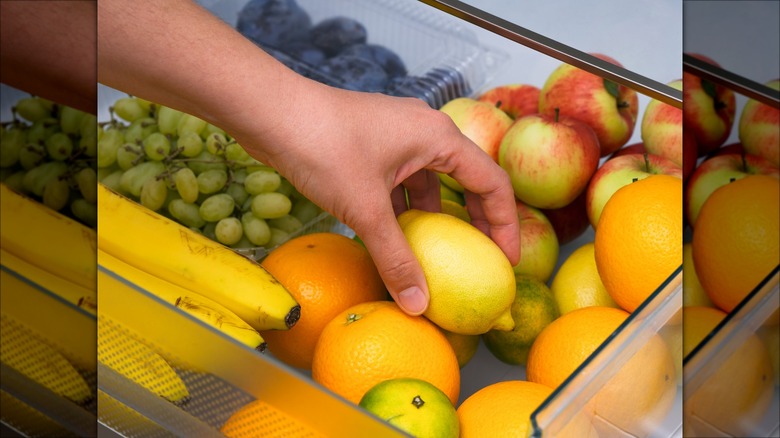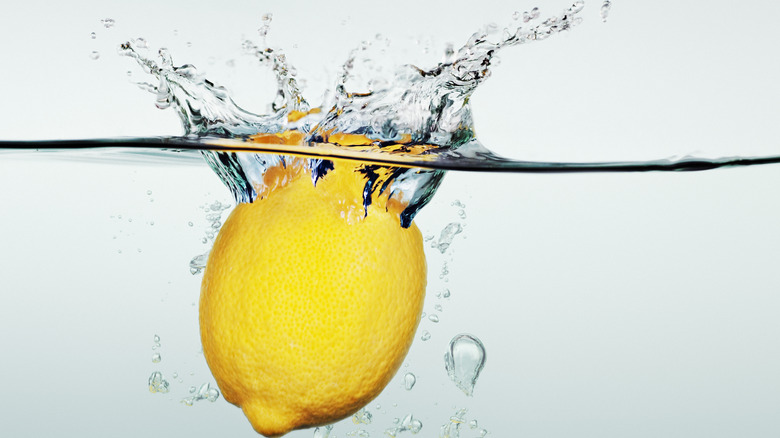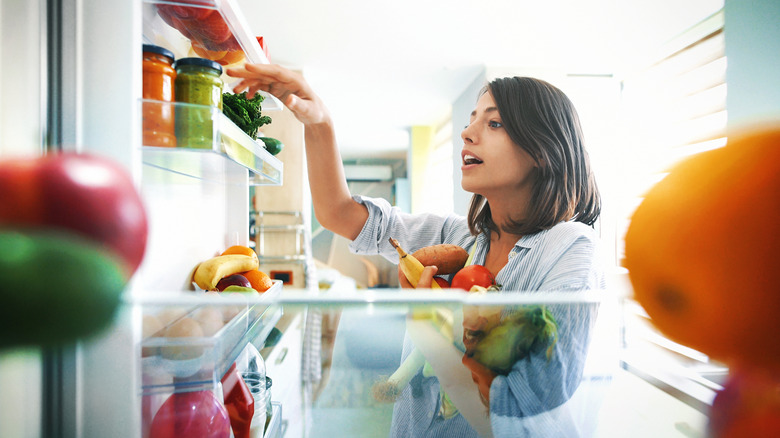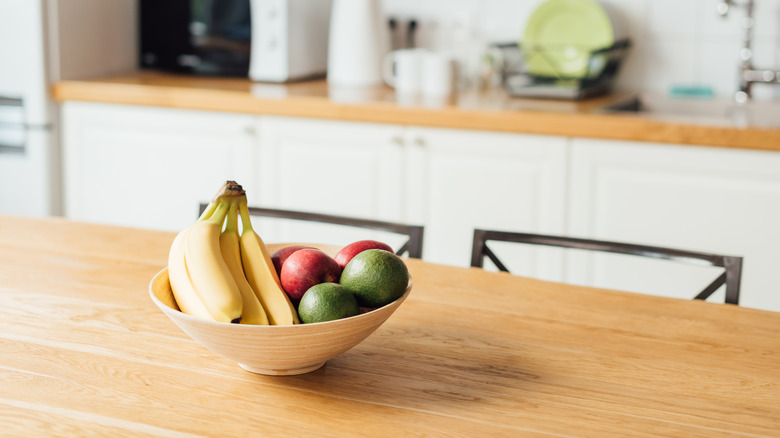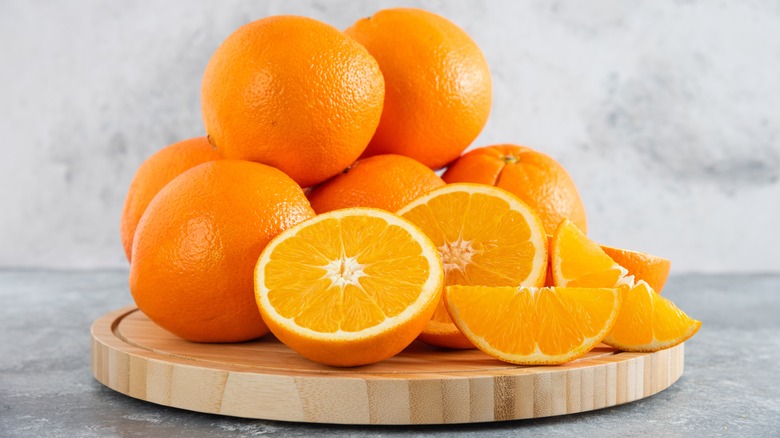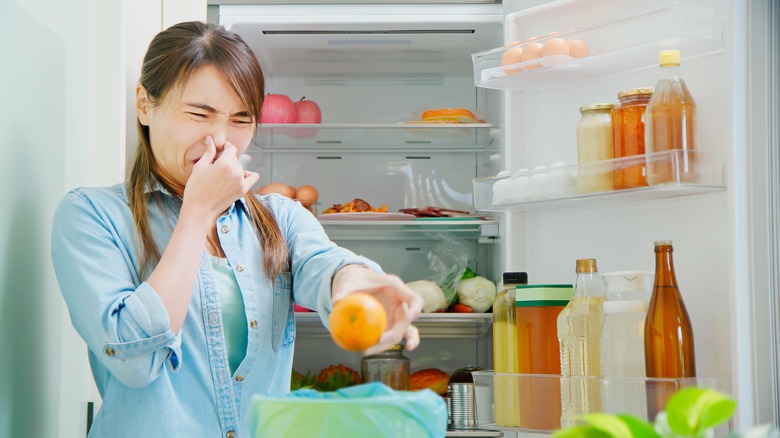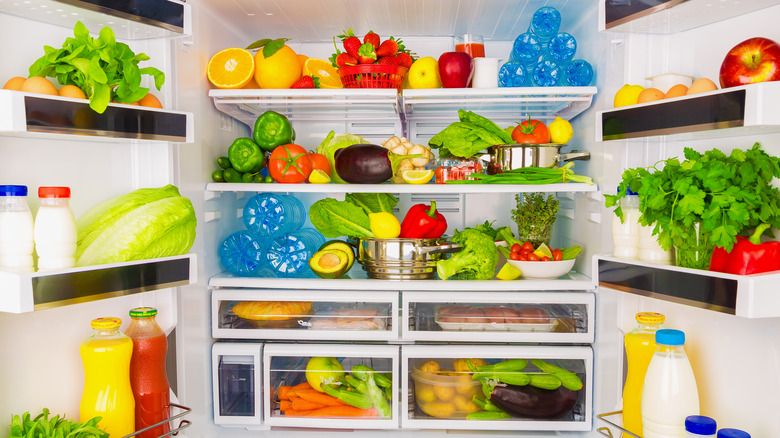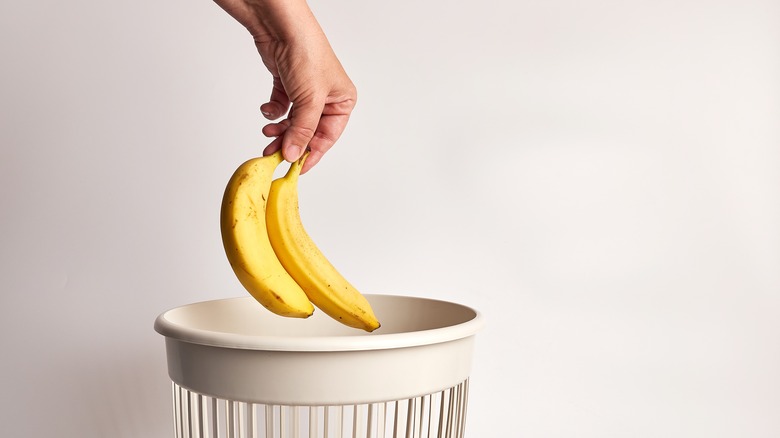12 Mistakes You're Making When Storing Your Fruit
Storing fruit seems like a straightforward task, but surprisingly, there are several common mistakes that many people inadvertently make. These errors can compromise the freshness, taste, and nutritional value of fruit, leading to unnecessary waste and disappointment. From improper temperature and humidity settings to early washing and overlooking the effects of ethylene gas, each aspect of storage plays a vital role in preserving the quality of your produce. Proper storage is especially important where fruits are concerned, as they can quickly mold or ripen — and then you end up having to toss the fruit out.
By understanding these typical missteps and learning how to avoid them, you can maximize the shelf life of your fruit, reduce unnecessary waste, and enjoy the full flavors and benefits that fresh fruits offer. Plus, by storing fruit properly, you could make the most of your storage options and create more space in your fridge for other groceries. Here, we'll shed light on these common mistakes when storing fruit and provide practical tips and solutions to help ensure your fruit stays delicious and nutritious for as long as possible.
1. Washing fruit too early
When you wash fruit — in particular, berries — before they're fully ripe or just before storage, you are providing them with moisture. Excess moisture, if not dried off completely, creates a perfect environment for mold and bacteria to thrive. Clearly, when it comes to keeping your just-purchased package of strawberries fresh, this is a real issue. With fruit prone to molding, you'll want to hold off on washing it until you're ready to eat it. That way, your fruit is spending less time wet, decreasing the chance for mold to grow before you get to it. It's also helpful to take a look at berries before washing them, in case mold has already started to affect some of the fruit. If you see any, it's wise to remove any affected berries to prevent the spread of mold to the rest.
If you're a wash-right-when-you-get-home kind of shopper, just make sure to thoroughly and gently pat your fruit dry. A good way to minimize moisture after washing fruit is by using a salad spinner. Finally, if you aren't going to immediately eat your fruit after washing, store it in a breathable container or a perforated plastic bag in the refrigerator. Keeping fruit in a well-ventilated container prevents excess moisture buildup.
2. Keeping the wrong fruits too close to each other
Fruits like bananas, apples, avocados, pears, tomatoes, and peaches are producers of ethylene, a gas that speeds up ripening. When stored near other fruits, especially those sensitive to ethylene, they can increase their ripening, too. Not all fruits are particularly sensitive to ethylene, but some fruits that are include honeydew, lemons, limes, grapes, and peaches. Ripening your fruits quickly isn't always a bad thing, but it becomes a problem when it causes premature ripening, softening, and spoilage.
Ideally, you should store compatible fruits together. If they all contain ethylene, it's safest to keep them close to each other so the gases don't interfere with other fruits. You could also store them next to produce that isn't sensitive to ethylene, such as blueberries and cherries. A good way to ensure this is to keep high-ethylene fruits like bananas or avocados on the counter until closer to the time you want to use them. You can also put ethylene-producing fruits in the fridge to slow down the ripening.
Aside from the effects of ethylene, some fruits can pass on their odors when too close to other varieties of fruit. For instance, potent-smelling oranges should be kept away from other produce. Keeping fruits away from vegetables is a hack that will keep your vegetables super fresh while protecting your fruits, too.
3. Using the original packaging
We'd reckon that many of us make the mistake of putting our berries right in the fridge in their original container. But this can become a problem for multiple reasons. Oftentimes, the original packaging lacks proper space for all the fruit to breathe, and can lead to moisture buildup and mold growth on the fruit. Ideally, fruit needs airflow to stay fresh. Plus, packaging from the store can hold onto any extra dirt from the fruit.
Instead, consider opting for air-tight, washable containers made of glass or BPA-free plastic to maintain freshness. Plastic zip bags with small perforations can also prevent mold and moisture by allowing airflow. Creating small holes or buying bags with them is key — a normal plastic zip bag without that added airflow could end up trapping moisture, ultimately defeating the purpose. For more sustainable options, there are silicone containers, which are flexible, reusable, and airtight, as well as beeswax wraps or cloth covers, which are especially handy for single fruits.
4. Keeping cut fruit too long
Once fruit is cut, it immediately starts to lose freshness as it's exposed to oxygen and bacteria. In particular, fruits with high water content, like melons, citrus fruits, and berries, are susceptible to spoiling once cut because their moisture provides a perfect environment for microbial growth and mold, even if they're refrigerated. It's best to not keep these fruits too long after they've been cut.
You should try to eat them as soon as possible, or store cut fruits like strawberries covered in the fridge for no more than three or four days. Moreover, meal-prepping — specifically, over-prepping — can cause problems when cutting an abundance of fruit. For instance, if those berries and oranges are going to spoil within a few days after cutting them, they likely won't make it throughout the full week of prepped meals.
Then there's the issue of fruits browning as they oxidize. Certain fruits, like avocados, apples, and bananas, are more prone to oxidation once they're cut. You've likely seen it –- you cut an avocado, tried to save half of it, and within a day or less it's already brown and needs to be tossed. Turns out, saving it with lemon juice is one of the absolute worst ways to store cut avocado. Instead, cover it tightly with plastic wrap to prevent air from getting to it and pop it in the fridge.
5. Storing it in the wrong drawer
Most refrigerators have drawers, and their purpose may go beyond sticking all of your cheese in there. Usually, crisper drawers have humidity settings that you can adjust for certain foods. There's kind of a fine line, as low-humidity drawers monitor the amount of moisture, and high-humidity drawers increase the moisture. Some fruits are susceptible to molding but are also prone to wilting or drying out. For example, strawberries can technically be placed in either drawer.
However, it can help to separate ethylene-sensitive fruits and ethylene producers in the drawers, such as putting sensitive fruits like citrus in the high-humidity drawer. These fruits also tend to dry out without any moisture, so the high-humidity drawer is a good option. You can put ethylene producers, such as apples, avocados, honeydew melons, kiwi, peaches, pears, and plums, in the low-humidity drawer to keep them away from the others and keep them free from mold or moisture.
And you don't necessarily have to follow this method based on ethylene. In general, low-humidity drawers or settings are ideal for fruits more likely to grow mold or spoil when around excess moisture. High-humidity drawers are good for more delicate fruits that are sensitive to moisture loss.
6. Neglecting to use water when necessary
Not all fruits benefit from being stored in water, but some fruits will stay crisp and maintain freshness by using this method. When you've cut fruits like apples, pears, or avocados, storing them in water can help keep their moisture levels and prevent browning without ruining their taste and texture. On the other hand, you can use water to store cucumbers so they don't turn into a soggy mess. Because they have a higher water content, they are easily affected by excess moisture. However, as soon as they're cut, they start to dry out, so submerging them in a container of water in the fridge can keep them crisp and hydrated.
Some fruits, like grapefruits, lemons, limes, and oranges, thrive with extra moisture, especially as their tougher skin can handle it without rotting too quickly. If you don't want to store them in your fridge's crisper drawer or don't have the space, you could put them in a bowl of water. This trick can save certain fruits and extend their shelf life, but it's still important to change the water regularly, especially if it becomes cloudy or after a day or two, to maintain the freshness.
7. Forgetting FIFO
If you're unfamiliar with the phrase, FIFO stands for First In, First Out, which means to rotate food to make sure you're using the first things bought earlier than other foods. Basically, if you put it in the fridge first, you should take it out of the fridge first. This is important because it maintains freshness — consuming older fruits prior to newer ones means you're using them before they go bad. If you go through the earlier fruits first, you're less likely to find spoiled or moldy fruits hidden at the back of the fridge. This can also help keep your fridge organized and tidy.
It's simple enough to implement FIFO — all it really requires is steady rotation. Periodically inspect your fruit storage spots, whether it's a fruit bowl, fridge, or pantry, and move older fruits to the front. If possible, you should label fruits with their purchase or storage date to help you keep track of which fruits need to be used first. It also helps to keep your storage space organized so you can easily get to older fruits. To save yourself time later, try to arrange them in a way that allows for easy rotation.
8. Not keeping fruits on the counter
Some fruits benefit from being stored in the fridge, but not all fruits need to be stored that way. For instance, pineapples don't keep ripening after they're harvested, so the fridge won't make a difference. Instead, you should aim to eat a ripe pineapple soon after buying it. Additionally, refrigeration can affect the flavor and texture of tomatoes. Instead, they should be stored at room temperature. The only instance when the fridge is more acceptable for tomatoes is if they're already ripe and you don't want them to ripen more, or if they've been cut and you're trying to save them for a couple of days. Still, cold temperatures could affect the flavor of your tomatoes.
Another kind of fruit that is better stored at room temperature is stone fruit, such as peaches, plums, and cherries. It can be a bad idea to refrigerate stone fruit, especially before they're ripe, because they can have a mealy or mushy texture or lose some of their flavor. It's best to let them ripen on the counter and then stick them in the fridge until you're ready to eat them. The same goes for melons, which can become hard when placed in the fridge — and we can all agree they're best when perfectly soft. Apples and pears also ripen well on the counter, but if they aren't stored in the fridge after, they can turn mealy.
9. Storing whole and cut fruits together
A huge, albeit common, mistake is putting your whole fruits with cut fruits in the same container. This isn't to say a prepared fruit cocktail can't swim around together in a container while it's stored in the fridge for a few days. But it does mean you should not stick the remaining whole fruits in the same container. First, when you cut fruits, their flesh is exposed, instantly making them a playground for bacteria. If you store them with whole fruit, you're risking the microbes from the cut fruits transferring to the whole ones, which can cause them to spoil faster. Even if you don't spot any signs of spoiling, the health hazards related to bacteria are still a real possibility because of the cross-contamination.
Then you need to consider ethylene again. Many whole fruits, especially those nearing ripeness, produce ethylene gas. Any cut fruits that are more sensitive to ethylene can ripen and spoil faster if they're placed together. This goes for storing cut avocados (a common ethylene producer) with whole ones, too. Finally, as soon as you cut fruits, they tend to release moisture, especially if they are stored improperly. Both cut and whole fruit can be affected by extra moisture, potentially turning the entire container into a soggy, juicy mess. Not only does this affect the quality of the cut fruit, but also it can quickly ruin the quality of the whole fruit.
10. Neglecting to clean the fridge
It's safe to say that a clean fridge is a good thing. Fruit isn't the only food that hangs out in there, and keeping up with the cleaning can help keep all your foods fresh for longer. Spills are common, leftovers linger, and both can accelerate the ripening and decay of fruits. We're not just talking about spills from containers, either. Some fruits release moisture or juices, especially when overripe or stored improperly, and those juices can spread to other fruits. Perhaps most importantly, a clean fridge helps to eliminate germs and bacteria that can contaminate fruits while minimizing the risk of cross-contamination from other foods.
Cleaning your refrigerator properly takes some know-how — but we're here to help! An easy way to keep up with the cleanliness is to wipe down the surfaces weekly and check the drawers for any spills. Store fruits in appropriate storage containers to contain any moisture or juice, and arrange and rotate fruits in a way that makes them easy to grab. Frequently check for any rotted fruit so you can remove it from the fridge before the problem spreads. With a little fridge upkeep, you're building a foundation for freshness.
11. Overcrowding the fridge
When fruits are packed tightly together, they can press against each other, leading to unsightly bruising or soft spots. Not only can bruises hasten the spoilage process, but they can also affect the taste. Plus, consider ethylene. If you overcrowd your fridge, you are likely placing ethylene-producers too close to everything else, which will accelerate ripening and cause early spoilage. Furthermore, insufficient airflow between fruits can create a humid and damp environment, promoting mold growth that can easily spread between fruits and other foods. By allowing space between everything, you're creating better air circulation, which helps maintain optimal temperature and humidity levels, keeping your fruit fresh longer.
Now, we get it — your fridge is only so big and can only fit so much. We suggest using baskets, mesh bags, or perforated plastic bags to store fruits in the fridge because these kinds of storage solutions provide ventilation and prevent direct contact. You could also opt for storage containers that keep everything organized and spaced out, such as plastic storage bins that come as stackable containers of various sizes.
12. Tossing fruit too early
If your fruit is downright rotten, trash it. But there are some foods you need to stop throwing out, since they can be repurposed. Fruit is no exception. Even when it's starting to go bad, it can still be saved in some ways. For instance, fruit peels are incredibly versatile. You can clean your coffee pot with lemon peels, salt, and ice. Dried citrus peels from fruits like oranges, limes, lemons, or grapefruit are also great for blending down into a powder which can also be used to add a burst of infused flavor to sugar, homemade lemon pepper, or olive oil. If you want a natural way to dye fabric, you can try simmering a pot of water with pomegranate peels.
Bananas are another fruit that can be utilized past its prime. First, when bananas start turning brown on the outside and mushy on the inside, they are finally at the best point for making banana bread or mixing into pancakes. Fruit pulp is also adaptable in several recipes. You can add it to smoothies, sauces, savory dishes, baked desserts, homemade juices, or popsicles. Additionally, fruit pits can be used in composting, or you can extract their flavor for infusions. And don't just limit your fruit to food. Citrus fruits also make face scrubs that are sustainable, while smelling great.
